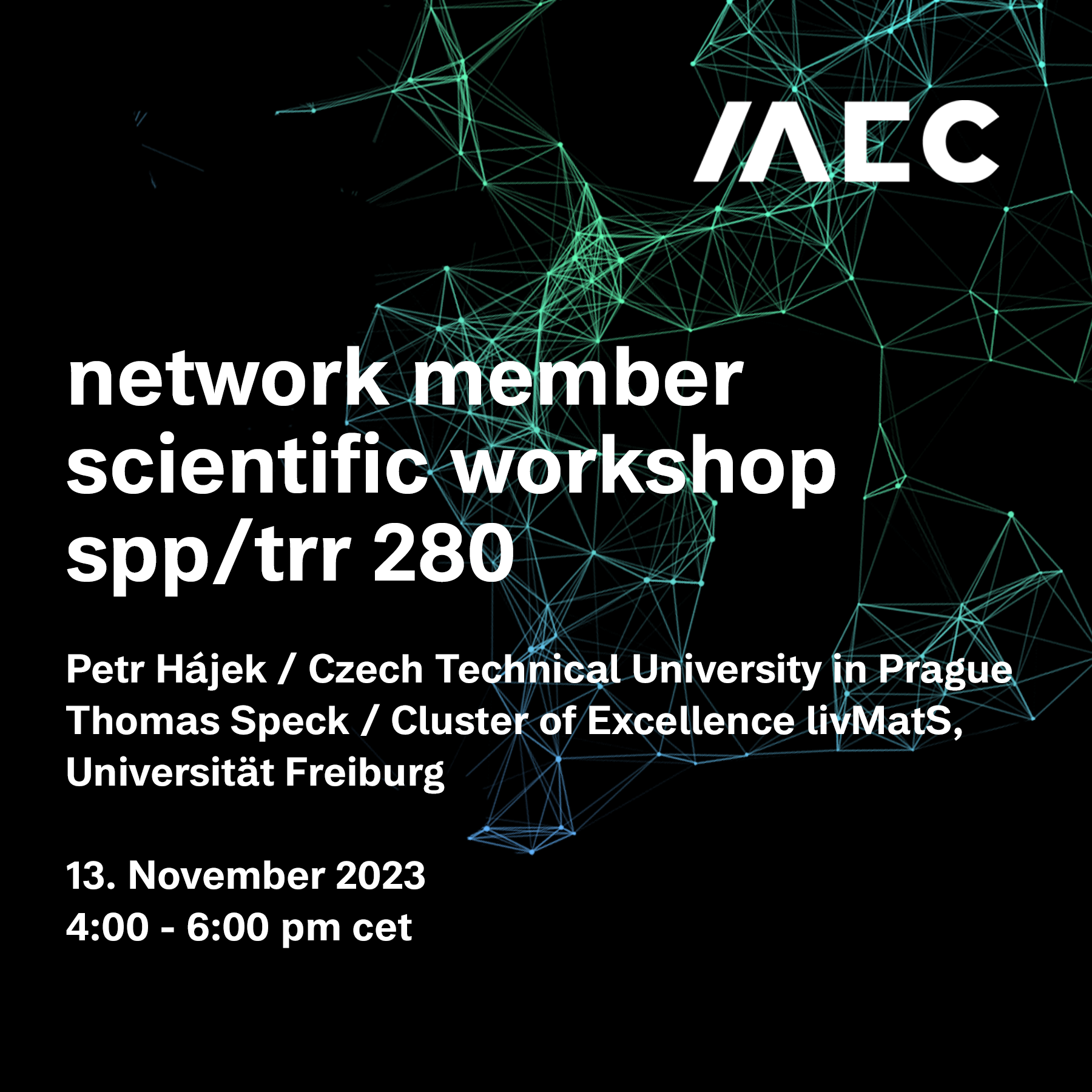
- This event has passed.
AAEC Network Member – Scientific Workshop SFB/TRR280 – Petr Hájek and Thomas Speck
November 13, 2023 | 4:00 pm - 6:00 pm

On behalf of the AdvanceAEC Partner SFB/TRR 280, we would like to invite you today’s
Scientific Workshop with Petr Hájek (Czech Technical University in Prague) and Thomas Speck (Cluster of Excellence livMatS, University of Freiburg) from 4:00–6:00 pm at TU Dresden and online:
Speaker 1:
Petr Hájek, Czech Technical University in Prague, Czech Republic
Title: “Contribution of Concrete Structures to Sustainable and Resilient Built Environment”
Speaker 2:
Thomas Speck, Cluster of Excellence livMatS, Universität Freiburg, Germany
Title: “Plants as inspiration for novel materials systems in engineering, architecture, medicine and soft machines”
The event will take place both in person and digitally:
The access data for this event is available to AdvanceAEC network partners. All researchers working in the field of AdvanceAEC are warmly invited to join the network. Please register or log-in to your account to access the event credentials.
We are looking forward to welcoming you.
The IntCDC Management Team
4:00 pm – Petr Hájek, Czech Technical University in Prague, Czech Republic
“Contribution of Concrete Structures to Sustainable and Resilient Built Environment”
Recent developments and changes in natural and socio-economic environment require new technical solutions for construction of new and modernization of existing structures. Buildings, infrastructure and the entire built environment should be better prepared for the new conditions – they should be sustain- nable, resilient and adaptable to new situations. Concrete and new advanced types of silicate composites gradually become building materials with high potential for new technical solutions resulting in needed environmental impact reduction and consequent social and economic improvement.
The International Federation for Structural Concrete (fib) is aware of the urgent need to motivate the concrete industry and the entire construction sector to contribute to the achievement of the Sustainable Development Goals and thus to contribute to the development of a sustainable and resilient environment. The new ModelCode 2020 (MC2020) not only addresses traditional safety and serviceability requirements, but incorporates sustainability, which becomes an overriding fundamental requirement responding to broader issues such as social responsibility, environmental quality, and economic efficiency. The basic principles for the design of concrete structures with a focus on their sustainability, applied in completed fib ModelCode 2020 will be presented.
Some examples of concrete structures contributing to sustainable and resilient environment will be presented as well.
5:00 pm – Thomas Speck, Universität Freiburg, Germany
“Plants as inspiration for novel materials systems in engineering, architecture, medicine and soft machines”
Biomimetics is attracting increasing attention in basic and applied research, as well as in industry and construction. Biomimetics has a high innovation potential and offers opportunities for the development of sustainable technical products and production chains. Novel, sophisticated methods for analysis and simulation of the form-structure-function relationship on different hierarchical levels allow fascinating new insights into biological material systems. In addition, for the first time, new production methods allow the transfer of many of the outstanding properties of biological models into innovative biomimetic products at reasonable cost.
In recent decades, plants have been recognised as valuable concept generators for biomimetic research in many application areas of technology, architecture and medicine. Plant-inspired materials systems for applications in architecture, medicine and soft machines are demonstrated by current research projects in the Plant Biomechanics Group Freiburg and the livMatS Cluster of Excellence. Examples of mobile systems include liana-inspired soft robots, façade shading systems inspired by leaves and flowers, demonstrators for self-adaptive building shells inspired by pine cones and silver thistle bracts, and artificial Venus fly traps. As an example of a medical application, a prototype of an adaptive wrist and forearm splint is presented. The cactus-inspired fibre pavilion is an example of the use of static plant-inspired and bio-based materials systems in architecture. As with all examples of architectural applications, it was developed in collaboration with the Cluster of Excellence IntCDC at the University of Stuttgart.